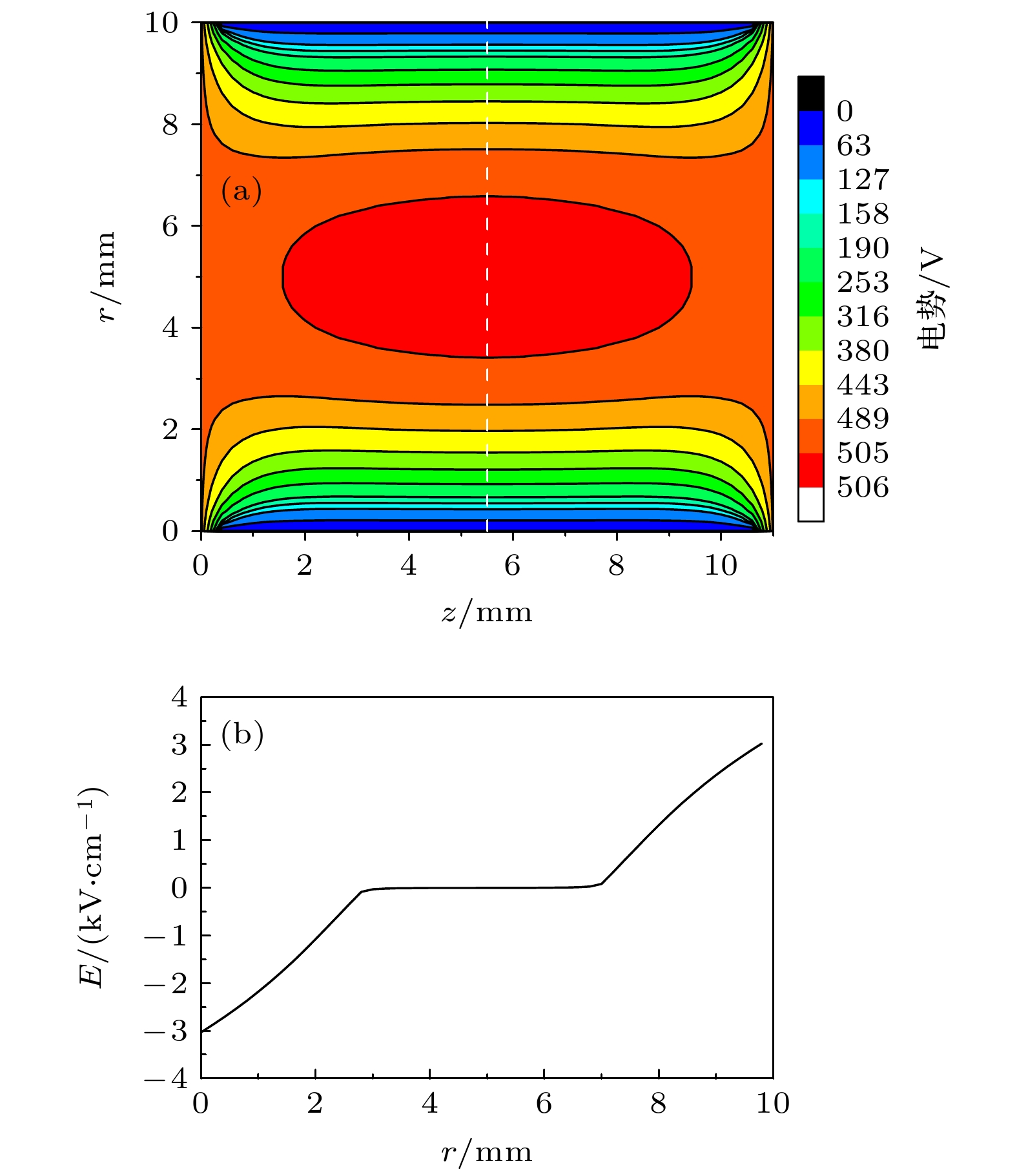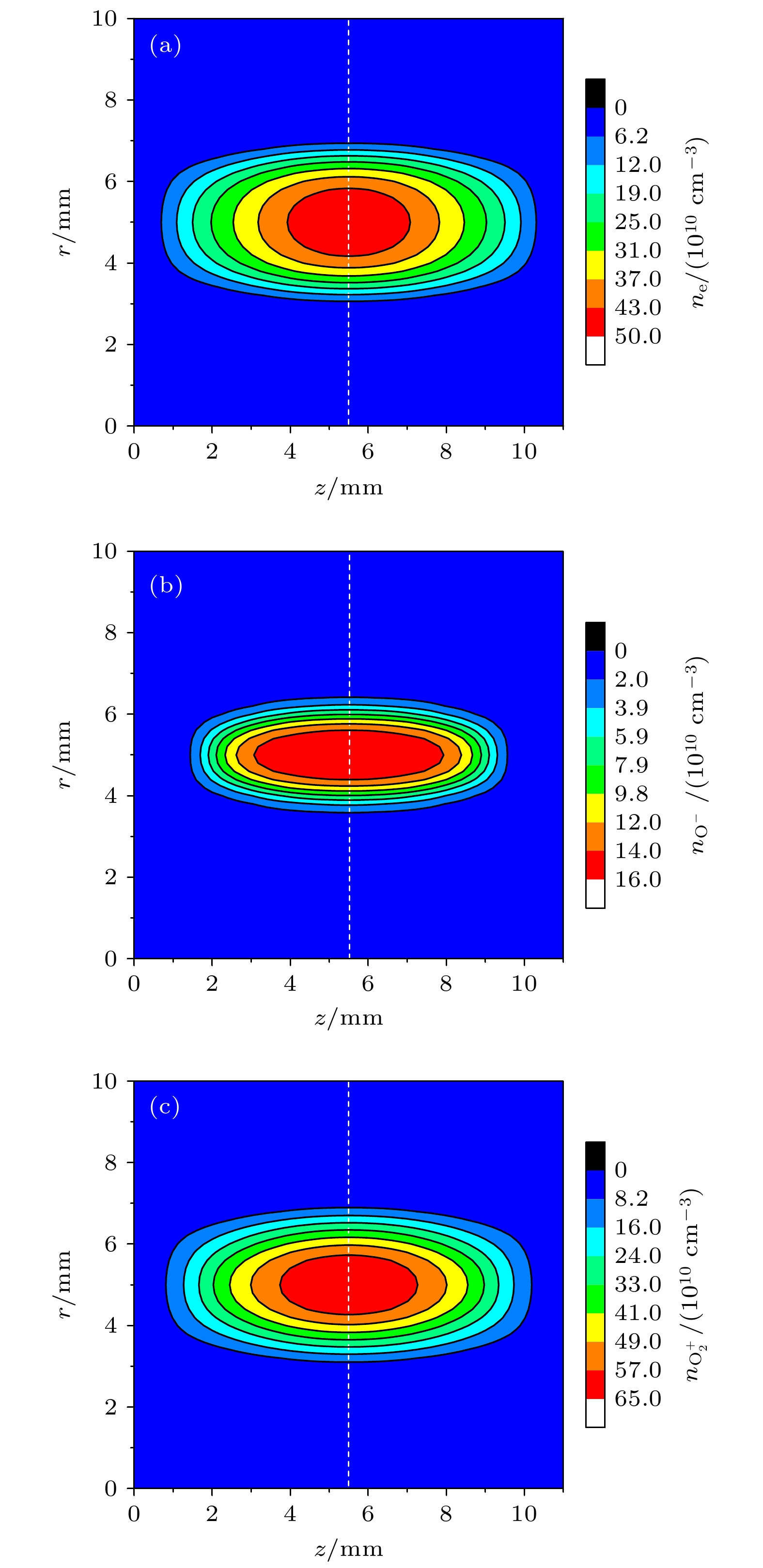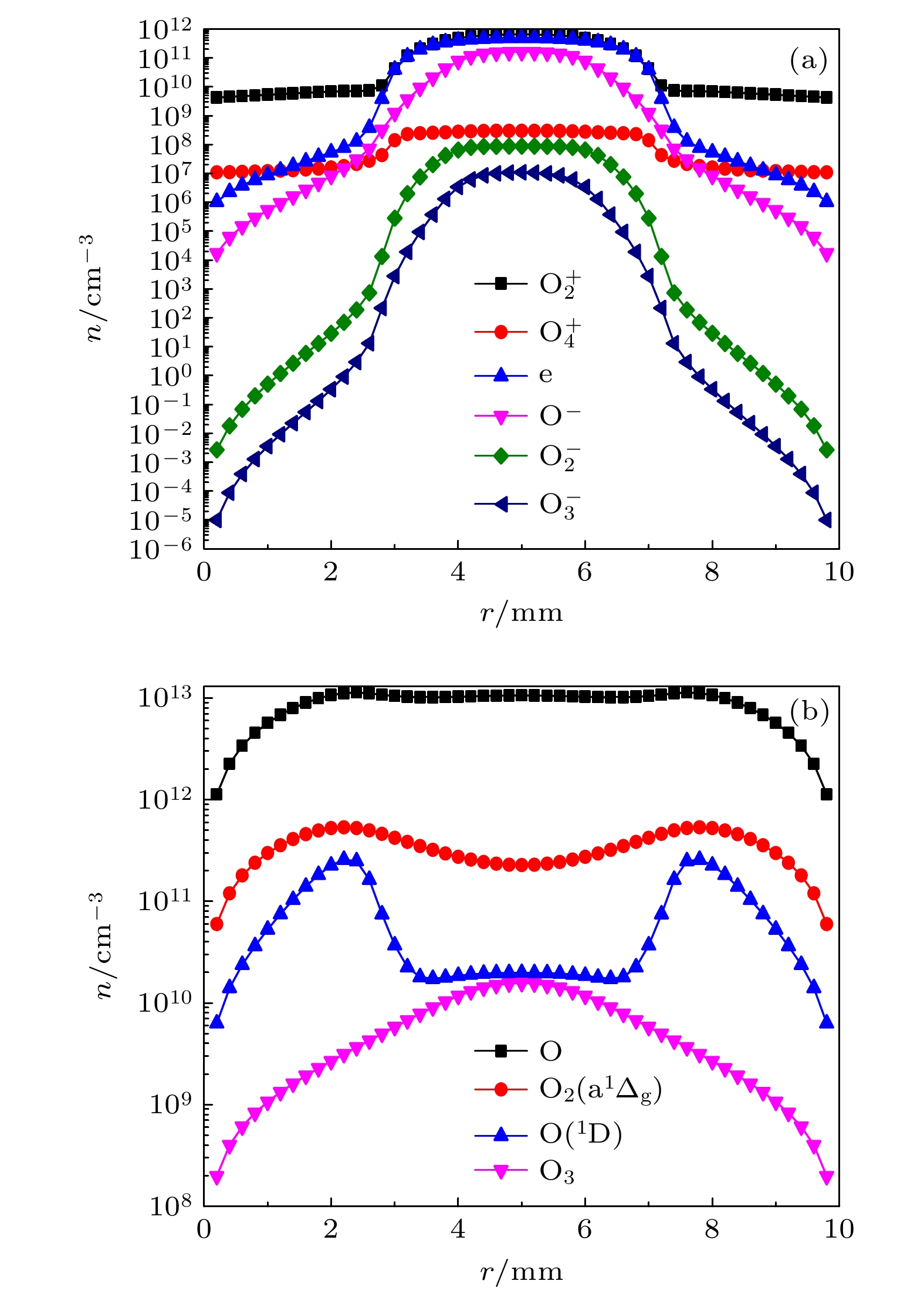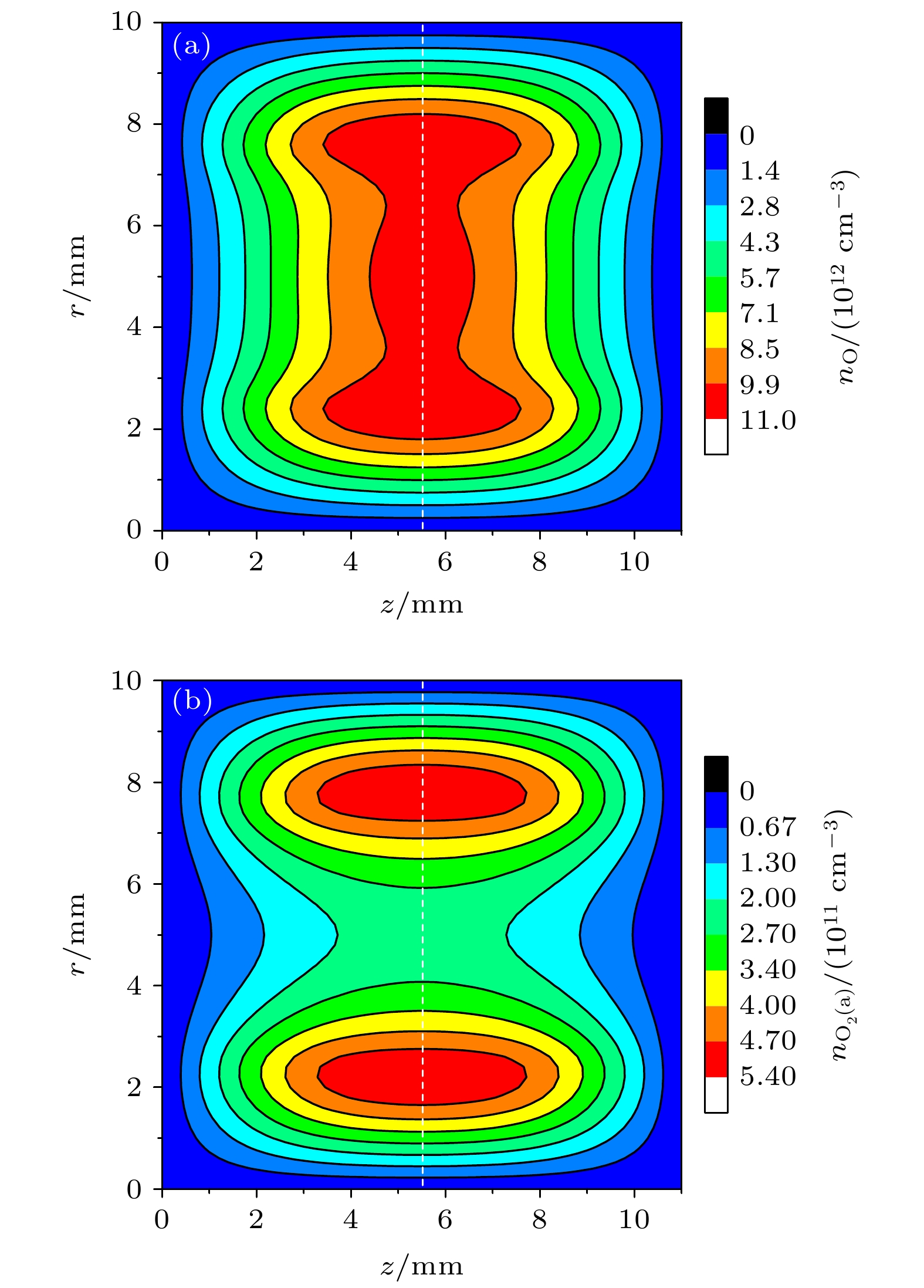-
本文利用流体模型对气压为266 Pa的氧气环境下空心阴极放电的放电特性及不同粒子的生成损耗机制进行了模拟研究. 模型中包含11种粒子和48个反应. 在该模拟条件下, 周围阴极所对应的负辉区产生重叠, 表明放电中存在较强的空心阴极效应. 计算得到了不同带电粒子与活性粒子的密度分布. 带电粒子密度主要位于放电单元中心区域, 电子和负氧离子O–是放电体系中主要的负电荷, 其密度峰值分别达到5.0 × 1011 cm–3和1.6 × 1011 cm–3;
${\rm{O}}_2^+ $ 是放电体系中主要的正电荷, 其密度峰值为6.5 × 1011 cm–3. 放电体系中同时存在丰富的活性氧粒子, 并且其密度远高于带电粒子, 按其密度高低依次为基态氧原子O、单重激发态氧分子O2(a1Δg)、激发态氧原子O(1D)、臭氧分子O3. 对电子、O–和${\rm{O}}_2^+ $ 的生成和损耗的反应动力学过程进行了深入分析, 同时给出了不同活性氧粒子的生成损耗路径概要图. 结果表明各粒子之间存在一个复杂的相互耦合的过程, 每一个反应在生成某种粒子的同时也在消耗相应的其他粒子, 最终各种粒子密度达到一个动态平衡.The characteristics, the formations and loss mechanisms of different particles of hollow cathode discharge in oxygen at 266 Pa are investigated by using the fluid model. The model contains 11 kinds of particles and 48 reactions. Under this simulation condition, the negative glow regions corresponding to the surrounding cathodes overlap. The results show that there is a strong hollow cathode effect. The density distributions of different charged and active particles are calculated. The charged particle density is located mainly in the central region of the discharge cell. Electrons and O– are the main ingredients of negative charges in the discharge system, and their density peaks are 5.0 × 1011 cm–3 and 1.6 × 1011 cm–3, respectively and${\rm{O}}_2^+ $ is a main composition of positive charge in the discharge system with a peak density of 6.5 × 1011 cm–3. Abundant active oxygen particles exist in the discharge system, and their density is much higher than those of other charged particles. According to the densities of active particles, their magnitudes are ranked in the small-to-large order as O, O2(a1Δg), O(1D) and O3. Furthermore, the generation and consumption mechanism of electrons, O– and${\rm{O}}_2^+ $ are calculated in detail, and the generation and consumption paths of different active oxygen particles are also given. The results show that there is a complex coupling process among these particles. Each reaction generates a certain number of particles and consumes other particles at the same time, resulting in a dynamic balance among these particles.-
Keywords:
- hollow cathode discharge /
- oxygen /
- fluid model /
- active particles /
- generation and consumption mechanism
[1] Nakagawa Y, Kawakita T, Uchida S, Tochikubo F 2020 J. Phys. D: Appl. Phys. 53 135201
 Google Scholar
Google Scholar
[2] Babu S K, Kelly S, Kechkar S, Swift P, Daniels S, Turner M M 2019 Plasma Sources Sci. Technol. 28 115008
 Google Scholar
Google Scholar
[3] Vagin N P, Ionin A A, Kochetov I V, Napartovich A P, Sinitsyn D V, Yuryshev N N 2017 Plasma Phys. Rep. 43 330
 Google Scholar
Google Scholar
[4] 陈维, 黄骏, 李辉, 吕国华, 王兴权, 张国权, 王鹏业, 杨思泽 2012 物理学报 61 185203
 Google Scholar
Google Scholar
Chen W, Huang J, Li H, Lv G H, Wang X Q, Zhang G Q, Wang P Y, Yang S Z 2012 Acta Phys. Sin. 61 185203
 Google Scholar
Google Scholar
[5] 欧阳吉庭, 张晨阳, 张宇, 刘思含, 缪劲松 2020 北京理工大学学报 40 908
 Google Scholar
Google Scholar
Ouyang J T, Zhang C Y, Zhang Y, Liu S H, Miao J S 2020 J. B. Inst. Techno. 40 908
 Google Scholar
Google Scholar
[6] Bakeev I Y, Klimov A S, Oks E M, Zenin A A 2021 Vacuum 187 110161
[7] Hou X Y, Zou X B, Li Y T, Zhang L W, Wang X X 2019 High Volt. 4 217
 Google Scholar
Google Scholar
[8] Korolev Y D, Koval N N 2018 J. Phys. D: Appl. Phys. 51 323001
 Google Scholar
Google Scholar
[9] Boeuf J P, Pitchford L C 2005 Appl. Phys. Lett. 86 071501
 Google Scholar
Google Scholar
[10] Fu Y Y, Verboncoeur J P, Christlieb A J 2017 Phys. Plasmas 24 103514
 Google Scholar
Google Scholar
[11] Cong S Y, Wu R H, Mu L, Sun J Z, Wang D Z 2019 J. Phys. D: Appl. Phys. 52 045205
 Google Scholar
Google Scholar
[12] Jiang X X, He F, Chen Q, Ge T, Ouyang J T 2014 Phys. Plasmas 21 033508
 Google Scholar
Google Scholar
[13] 夏广庆, 薛伟华, 陈茂林, 朱雨, 朱国强 2011 物理学报 60 015201
 Google Scholar
Google Scholar
Xia G Q, Xue W H, Chen M L, Zhu Y, Zhu G Q 2011 Acta Phys. Sin. 60 015201
 Google Scholar
Google Scholar
[14] Wei H C, Wang N, Duan Z C, He F 2018 Phys. Plasmas 25 123513
 Google Scholar
Google Scholar
[15] Hou X Y, Fu Y Y, Wang H, Zou X B, Luo H Y, Wang X X 2017 Phys. Plasmas 24 083506
 Google Scholar
Google Scholar
[16] 何寿杰, 张钊, 赵雪娜, 李庆 2017 物理学报 66 055101
 Google Scholar
Google Scholar
He S J, Zhang Zhao, Zhao X N, Li Q 2017 Acta Phys. Sin. 66 055101
 Google Scholar
Google Scholar
[17] Lavrukevich Y, Ryabtsev A, Tsiolko V 2017 Probl. At. Sci. Technol. 107 215
[18] Bazhenov V Y, Matsevich S V, Piun V M, Tsiolko V V 2015 Probl. At. Sci. Technol. 98 177
[19] Yamatake A, Yasuoka K, Ishii S 2004 Jpn. J. Appl. Phys. 43 6381
 Google Scholar
Google Scholar
[20] Qin Y, He F, Jiang X X, Xie K, Ouyang J T 2014 Phys. Plasmas 21 073501
 Google Scholar
Google Scholar
[21] Matsui M, Ikemoto T, Takayanagi H, Komurasaki K, Arakawa Y 2006 Vacuum 80 1161
 Google Scholar
Google Scholar
[22] He S J, Ha J, Liu S M, Ouyang J T 2013 Phys. Plasmas 20 123504
 Google Scholar
Google Scholar
[23] He J, Zhang Y T T 2012 Plasma Processes Polym. 9 919
 Google Scholar
Google Scholar
[24] Hsu C C, Nierode M A, Coburn J W, Graves D B 2006 J. Phys. D: Appl. Phys. 39 3272
 Google Scholar
Google Scholar
[25] Park G, Lee H, Kim G, Lee J K 2008 Plasma Processes Polym. 5 569
 Google Scholar
Google Scholar
[26] Sakiyama Y, Graves D B, Chang H W, Shimizu T, Morfill G E 2012 J. Phys. D: Appl. Phys. 45 425201
 Google Scholar
Google Scholar
[27] Baulch D L, Cox R A, Crutzen P J, Hampson R F, Kerr J A, Troe J, Watson R T 1982 J. Phys. Chem. Ref. Data 11 327
 Google Scholar
Google Scholar
[28] Stafford D S, Kushner M J 2004 J. Appl. Phys. 96 2451
 Google Scholar
Google Scholar
[29] 冯静 2018 硕士学位论文 (大连: 大连理工大学)
Feng J 2018 M. S. Dissertation (Dalian: Dalian University of Technology) (in Chinese)
[30] Kossyi I A, Kostinsky A Y, Matveyev A A 1992 Plasma Sources Sci. Technol. 1 207
 Google Scholar
Google Scholar
[31] Yanallah K, Pontiga F, Fernández-Rueda A, Castellanos A, Belasri A 2008 J. Phys. D: Appl. Phys. 41 195206
 Google Scholar
Google Scholar
[32] Soria C, Pontiga F, Castellanos A 2004 Plasma Sources Sci. Technol. 13 95
 Google Scholar
Google Scholar
[33] Bogdanov E A, Kudryavtsev A A, Tsendin L D, Arslanbekov R R, Kolobov V I, Kudryavtsev V V 2003 Tech. Phys. 48 983
 Google Scholar
Google Scholar
[34] Xu J Z, Zhong P, Li J L, Lin J, Diao Y, Zhang J 2010 Plasma Sci. Technol. 12 601
 Google Scholar
Google Scholar
[35] Gaens W V, Bogaerts A 2013 J. Phys. D:Appl. Phys. 46 275201
[36] Lazzaroni C, Chabert P 2016 Plasma Sources Sci. Technol. 25 065015
 Google Scholar
Google Scholar
[37] Donkó Z 1998 Phys. Rev. E 57 7126
 Google Scholar
Google Scholar
[38] Wei L S, Peng B F, Li M, Zhang Y F 2016 Vacuum 125 123
 Google Scholar
Google Scholar
[39] Pan G S, Tan Z Y, Pan J, Wang X L, Shan C H 2016 Phys. Plasmas 23 043508
 Google Scholar
Google Scholar
[40] Duran-Olivencia F J, Pontiga F, Castellanos A 2014 J. Phys. D:Appl. Phys. 47 415203
 Google Scholar
Google Scholar
[41] Hagelaar G J, Hoog F J, Kroesen G M 2000 Phys. Rev. E 62 1452
 Google Scholar
Google Scholar
[42] Laca M, Morávek M J, Schmiedt, Luká, Hrachová V, Kaňka A 2017 Contrib. Plasma Phys. 57 336
 Google Scholar
Google Scholar
[43] 周志向 2020 硕士学位论文 (保定: 河北大学)
Zhou Z X 2020 M. S. Dissertation (Baoding: Hebei University) (in Chinese)
[44] Costin C, Minea T M, Popa G, Gousset G 2010 J. Vac. Sci. Technol. A 28 322
 Google Scholar
Google Scholar
[45] Yang A J, Wang X H, Rong M Z, Liu D X, Iza F, Kong M G 2011 Phys. Plasmas 18 113503
[46] 洪布双, 苑涛, 邹帅, 唐中华, 徐东升, 虞一青, 王栩生, 辛煜 2013 物理学报 62 115202
 Google Scholar
Google Scholar
Hong B S, Yuan T, Zou S, Tang Z H, Xu D S, Yu Y Q, Wang X S, Xin Y 2013 Acta Phys. Sin. 62 115202
 Google Scholar
Google Scholar
[47] 王晓龙, 谭震宇, 潘光胜, 单春虹 2018 高电压技术 44 904
 Google Scholar
Google Scholar
Wang X L, Tan Z Y, Pan G S, Shan C H 2018 High Volt. Engineer. 44 904
 Google Scholar
Google Scholar
-
表 1 放电反应类型
Table 1. Discharge reactions in the model.
反应标号 反应方程 反应标号 反应方程 G1 e + O2 → 2O + e[23] G25 O3 + O(1D) → O2 + 2O[26] G2 e + O2 → ${\rm{O}}_2^+ $ + 2e [23] G26 O3 + O(1D) → 2O2[26] G3 e + O– → O + 2e [23] G27 ${\rm{O}}_2^ + $ + O2 + O2 → ${\rm{O}}_4^+ $ + O2[29] G4 e + O2 →O + O(1D) + e[23] G28 ${\rm{O}}_4^+$ + O2 → ${\rm{O}}_2^ + $ + O2 + O2[30] G5 e + O → O(1D) + e[23] G29 ${\rm{O}}_4^ + $ + O → ${\rm{O}}_2^ + $ + O3[29] G6 e + O2(a1∆g) → 2O + e[24] G30 e + O(1D) → O + e[23] G7 e + O2 → O– + O[23] G31 O3 + O2 → 2O2 + O[25] G8 e + O3 → ${\rm{O}}_2^ -$ + O[23] G32 O– + O2(a1∆g) → O3 + e[23] G9 e + ${\rm{O} }_2^ +$ → 2O[25] G33 O– + O2(a1∆g) → ${\rm{O}}_2^ - $ + O[23] G10 O– + ${\rm{O} }_2^+$ → 3O[25] G34 O3 + O → O2(a1∆g) + O2 [31] G11 O– + O → e + O2[25] G35 O3 + O(1D) → O2(a1∆g) + O2[32] G12 O– + O2 → O3 + e[25] G36 O3 + O(1D) → 2O2(a1∆g) [32] G13 ${\rm{O}}_2^ + $ + ${\rm{O}}_2^ - $ → 2O2 [26] G37 ${\rm{O}}_4^ + $ + ${\rm{O}}_3^ - $ → 3O2 + O[33] G14 O3 + O → 2O2[25] G38 ${\rm{O}}_4^ + $ + O– → O2 + O3[33] G15 O3 + ${\rm{O}}_2^ - $→ ${\rm{O}}_3^ - $ + O2[26] G39 ${\rm{O}}_4^ + $ + O2(a1∆g) → ${\rm{O}}_2^ + $ + O2 + O2[29] G16 O– + O3 → ${\rm{O}}_3^ - $ + O[26] G40 e +${\rm{O}}_4^ + $ → O2 + O2[34] G17 ${\rm{O}}_3^ - $ + O → ${\rm{O}}_2^ - $ + O2[27] G41 ${\rm{O}}_4^ + $ + ${\rm{O}}_2^ - $→ 3O2[33] G18 ${\rm{O}}_3^ - $ + ${\rm{O}}_2^+ $ → O3 + 2O[28] G42 ${\rm{O}}_4^ + $ + O– → O + O2 + O2[35] G19 O2(a1∆g) + O2 → 2O2[25] G43 ${\rm{O}}_4^ + $ + ${\rm{O}}_2^ - $ → O + O + O2 + O2[35] G20 O2(a1∆g) + O → O + O2[25] G44 ${\rm{O}}_4^ + $ + ${\rm{O}}_3^ - $→ O3 + O2 + O2[35] G21 O(1D) + O → 2O[23] G45 ${\rm{O}}_2^ - $ + O → O– + O2[32] G22 O(1D) + O2 → O + O2[26] G46 O + O + O2 → O + O3[36] G23 O(1D) + O2 → O + O2(a1∆g)[26] G47 O + O2 + O2 → O2 + O3[36] G24 O3 + O2(a1∆g) → 2O2 + O[25] G48 O + O2 + O3 → O3 + O3[36] 表 2 电子生成与消耗反应的相应贡献
Table 2. The ratio of electron generation and consumption for different reactions.
电子生成反应 贡献/% 电子消耗反应 贡献/% G2: e + O2 → ${\rm{O}}_2^+ $+ 2e 99.875 G7: e + O2 → O– + O 42.418 G11: O– + O → e + O2 0.114 G40: e + ${\rm{O}}_4^+ $→ O2 + O2 31.748 G12: O– + O2 → O3 + e 0.008 G9: e + ${\rm{O}}_2^+ $ → 2O 25.808 G32: O– + O2(a1∆g) → O3 + e 0.002 G8: e + O3 → ${\rm{O}}_2^- $ + O 0.026 G3: e + O– → O + 2e 7.0 × 10–4 表 3 O–生成与消耗反应的相应贡献
Table 3. Ratio of O–generation and consumption for different reactions.
O–生成反应 贡献/% O–消耗反应 贡献/% G7: e + O2 → O– + O 99.998 G10: O– +${\rm{O} }_2^+ $ → 3O 86.712 G45: ${\rm{O} }_2^- $ + O → O– + O2 0.002 G11: O– + O → e + O2 8.548 G38: ${\rm{O} }_4^+ $ + O– → O2 + O3 3.809 G12: O– + O2 → O3 + e 0.631 G32: O– + O2(a1∆g) → O3 + e 0.135 G42: ${\rm{O} }_4^+ $ + O– → O + O2 + O2 0.055 G3: e + O– → O + 2e 0.055 G33: O– + O2(a1∆g) → ${\rm{O} }_2^- $ + O 0.045 G16: O– + O3 → ${\rm{O} }_3^- $ + O 0.011 表 4
${\rm{O} }_2^+ $ 生成与消耗反应的相应贡献Table 4. The ratio of
${\rm{O} }_2^+ $ generation and consumption for different reactions.${\rm{O} }_2^+ $生成反应 贡献/% ${\rm{O} }_2^+ $消耗反应 贡献/% G2: e + O2 → ${\rm{O} }_2^+ $ + 2e 99.993 G27: ${\rm{O} }_2^+ $ + O2 + O2 → ${\rm{O} }_4^+ $ + O2 44.657 G28: ${\rm{O} }_4^+ $ + O2 → ${\rm{O} }_2^+ $ + O2 + O2 0.007 G9: e + ${\rm{O} }_2^+ $ → 2O 30.675 G29: ${\rm{O} }_4^+ $ + O → ${\rm{O} }_2^+ $ + O3 5.8×10–4 G10: O– + ${\rm{O} }_2^+ $ → 3O 24.634 G39: ${\rm{O} }_4^+ $ + O2(a1∆g)→${\rm{O} }_2^+ $ + O2 + O2 6.9×10–6 G13: ${\rm{O} }_2^+ $ + ${\rm{O} }_2^- $ → 2O2 0.032 G18: ${\rm{O} }_3^-$ +${\rm{O} }_2^+ $ → O3 + 2O 0.002 表 5 O生成与消耗反应的相应贡献
Table 5. Ratio of O generation and consumption for different reactions.
O生成反应 贡献/% O消耗反应 贡献/% G4: e + O2 → O + O(1D) + e 45.255 G5: e + O → O(1D) + e 56.855 G22: O(1D) + O2 → O + O2 39.217 G11: O– + O → e + O2 26.231 G1: e + O2 → 2O + e 8.725 G47: O2 + O2 + O → O2 + O3 16.765 G23:O(1D) + O2→O + O2(a1∆g) 5.602 G29: ${\rm{O} }_4^+ $ + O → ${\rm{O} }_2^+ $ + O3 0.135 G7: e + O2 → O– + O 0.567 G45: ${\rm{O} }_2^-$ + O→ O– + O2 0.012 G9: e +${\rm{O} }_2^+ $ → 2O 0.345 G46: O + O + O2 → O + O3 0.001 G10: O– + ${\rm{O} }_2^+ $ → 3O 0.277 G17: ${\rm{O} }_3^- $ + O → ${\rm{O} }_2^- $ + O2 7.7 × 10–4 其他 0.012 G14: O3 + O → 2O2 3.4 × 10–4 G34: O3 + O→O2(a1∆g) + O2 1.9 × 10–4 G48: O + O2 + O3 → O3 + O3 6.0 × 10–7 -
[1] Nakagawa Y, Kawakita T, Uchida S, Tochikubo F 2020 J. Phys. D: Appl. Phys. 53 135201
 Google Scholar
Google Scholar
[2] Babu S K, Kelly S, Kechkar S, Swift P, Daniels S, Turner M M 2019 Plasma Sources Sci. Technol. 28 115008
 Google Scholar
Google Scholar
[3] Vagin N P, Ionin A A, Kochetov I V, Napartovich A P, Sinitsyn D V, Yuryshev N N 2017 Plasma Phys. Rep. 43 330
 Google Scholar
Google Scholar
[4] 陈维, 黄骏, 李辉, 吕国华, 王兴权, 张国权, 王鹏业, 杨思泽 2012 物理学报 61 185203
 Google Scholar
Google Scholar
Chen W, Huang J, Li H, Lv G H, Wang X Q, Zhang G Q, Wang P Y, Yang S Z 2012 Acta Phys. Sin. 61 185203
 Google Scholar
Google Scholar
[5] 欧阳吉庭, 张晨阳, 张宇, 刘思含, 缪劲松 2020 北京理工大学学报 40 908
 Google Scholar
Google Scholar
Ouyang J T, Zhang C Y, Zhang Y, Liu S H, Miao J S 2020 J. B. Inst. Techno. 40 908
 Google Scholar
Google Scholar
[6] Bakeev I Y, Klimov A S, Oks E M, Zenin A A 2021 Vacuum 187 110161
[7] Hou X Y, Zou X B, Li Y T, Zhang L W, Wang X X 2019 High Volt. 4 217
 Google Scholar
Google Scholar
[8] Korolev Y D, Koval N N 2018 J. Phys. D: Appl. Phys. 51 323001
 Google Scholar
Google Scholar
[9] Boeuf J P, Pitchford L C 2005 Appl. Phys. Lett. 86 071501
 Google Scholar
Google Scholar
[10] Fu Y Y, Verboncoeur J P, Christlieb A J 2017 Phys. Plasmas 24 103514
 Google Scholar
Google Scholar
[11] Cong S Y, Wu R H, Mu L, Sun J Z, Wang D Z 2019 J. Phys. D: Appl. Phys. 52 045205
 Google Scholar
Google Scholar
[12] Jiang X X, He F, Chen Q, Ge T, Ouyang J T 2014 Phys. Plasmas 21 033508
 Google Scholar
Google Scholar
[13] 夏广庆, 薛伟华, 陈茂林, 朱雨, 朱国强 2011 物理学报 60 015201
 Google Scholar
Google Scholar
Xia G Q, Xue W H, Chen M L, Zhu Y, Zhu G Q 2011 Acta Phys. Sin. 60 015201
 Google Scholar
Google Scholar
[14] Wei H C, Wang N, Duan Z C, He F 2018 Phys. Plasmas 25 123513
 Google Scholar
Google Scholar
[15] Hou X Y, Fu Y Y, Wang H, Zou X B, Luo H Y, Wang X X 2017 Phys. Plasmas 24 083506
 Google Scholar
Google Scholar
[16] 何寿杰, 张钊, 赵雪娜, 李庆 2017 物理学报 66 055101
 Google Scholar
Google Scholar
He S J, Zhang Zhao, Zhao X N, Li Q 2017 Acta Phys. Sin. 66 055101
 Google Scholar
Google Scholar
[17] Lavrukevich Y, Ryabtsev A, Tsiolko V 2017 Probl. At. Sci. Technol. 107 215
[18] Bazhenov V Y, Matsevich S V, Piun V M, Tsiolko V V 2015 Probl. At. Sci. Technol. 98 177
[19] Yamatake A, Yasuoka K, Ishii S 2004 Jpn. J. Appl. Phys. 43 6381
 Google Scholar
Google Scholar
[20] Qin Y, He F, Jiang X X, Xie K, Ouyang J T 2014 Phys. Plasmas 21 073501
 Google Scholar
Google Scholar
[21] Matsui M, Ikemoto T, Takayanagi H, Komurasaki K, Arakawa Y 2006 Vacuum 80 1161
 Google Scholar
Google Scholar
[22] He S J, Ha J, Liu S M, Ouyang J T 2013 Phys. Plasmas 20 123504
 Google Scholar
Google Scholar
[23] He J, Zhang Y T T 2012 Plasma Processes Polym. 9 919
 Google Scholar
Google Scholar
[24] Hsu C C, Nierode M A, Coburn J W, Graves D B 2006 J. Phys. D: Appl. Phys. 39 3272
 Google Scholar
Google Scholar
[25] Park G, Lee H, Kim G, Lee J K 2008 Plasma Processes Polym. 5 569
 Google Scholar
Google Scholar
[26] Sakiyama Y, Graves D B, Chang H W, Shimizu T, Morfill G E 2012 J. Phys. D: Appl. Phys. 45 425201
 Google Scholar
Google Scholar
[27] Baulch D L, Cox R A, Crutzen P J, Hampson R F, Kerr J A, Troe J, Watson R T 1982 J. Phys. Chem. Ref. Data 11 327
 Google Scholar
Google Scholar
[28] Stafford D S, Kushner M J 2004 J. Appl. Phys. 96 2451
 Google Scholar
Google Scholar
[29] 冯静 2018 硕士学位论文 (大连: 大连理工大学)
Feng J 2018 M. S. Dissertation (Dalian: Dalian University of Technology) (in Chinese)
[30] Kossyi I A, Kostinsky A Y, Matveyev A A 1992 Plasma Sources Sci. Technol. 1 207
 Google Scholar
Google Scholar
[31] Yanallah K, Pontiga F, Fernández-Rueda A, Castellanos A, Belasri A 2008 J. Phys. D: Appl. Phys. 41 195206
 Google Scholar
Google Scholar
[32] Soria C, Pontiga F, Castellanos A 2004 Plasma Sources Sci. Technol. 13 95
 Google Scholar
Google Scholar
[33] Bogdanov E A, Kudryavtsev A A, Tsendin L D, Arslanbekov R R, Kolobov V I, Kudryavtsev V V 2003 Tech. Phys. 48 983
 Google Scholar
Google Scholar
[34] Xu J Z, Zhong P, Li J L, Lin J, Diao Y, Zhang J 2010 Plasma Sci. Technol. 12 601
 Google Scholar
Google Scholar
[35] Gaens W V, Bogaerts A 2013 J. Phys. D:Appl. Phys. 46 275201
[36] Lazzaroni C, Chabert P 2016 Plasma Sources Sci. Technol. 25 065015
 Google Scholar
Google Scholar
[37] Donkó Z 1998 Phys. Rev. E 57 7126
 Google Scholar
Google Scholar
[38] Wei L S, Peng B F, Li M, Zhang Y F 2016 Vacuum 125 123
 Google Scholar
Google Scholar
[39] Pan G S, Tan Z Y, Pan J, Wang X L, Shan C H 2016 Phys. Plasmas 23 043508
 Google Scholar
Google Scholar
[40] Duran-Olivencia F J, Pontiga F, Castellanos A 2014 J. Phys. D:Appl. Phys. 47 415203
 Google Scholar
Google Scholar
[41] Hagelaar G J, Hoog F J, Kroesen G M 2000 Phys. Rev. E 62 1452
 Google Scholar
Google Scholar
[42] Laca M, Morávek M J, Schmiedt, Luká, Hrachová V, Kaňka A 2017 Contrib. Plasma Phys. 57 336
 Google Scholar
Google Scholar
[43] 周志向 2020 硕士学位论文 (保定: 河北大学)
Zhou Z X 2020 M. S. Dissertation (Baoding: Hebei University) (in Chinese)
[44] Costin C, Minea T M, Popa G, Gousset G 2010 J. Vac. Sci. Technol. A 28 322
 Google Scholar
Google Scholar
[45] Yang A J, Wang X H, Rong M Z, Liu D X, Iza F, Kong M G 2011 Phys. Plasmas 18 113503
[46] 洪布双, 苑涛, 邹帅, 唐中华, 徐东升, 虞一青, 王栩生, 辛煜 2013 物理学报 62 115202
 Google Scholar
Google Scholar
Hong B S, Yuan T, Zou S, Tang Z H, Xu D S, Yu Y Q, Wang X S, Xin Y 2013 Acta Phys. Sin. 62 115202
 Google Scholar
Google Scholar
[47] 王晓龙, 谭震宇, 潘光胜, 单春虹 2018 高电压技术 44 904
 Google Scholar
Google Scholar
Wang X L, Tan Z Y, Pan G S, Shan C H 2018 High Volt. Engineer. 44 904
 Google Scholar
Google Scholar
计量
- 文章访问数: 7764
- PDF下载量: 97
- 被引次数: 0
















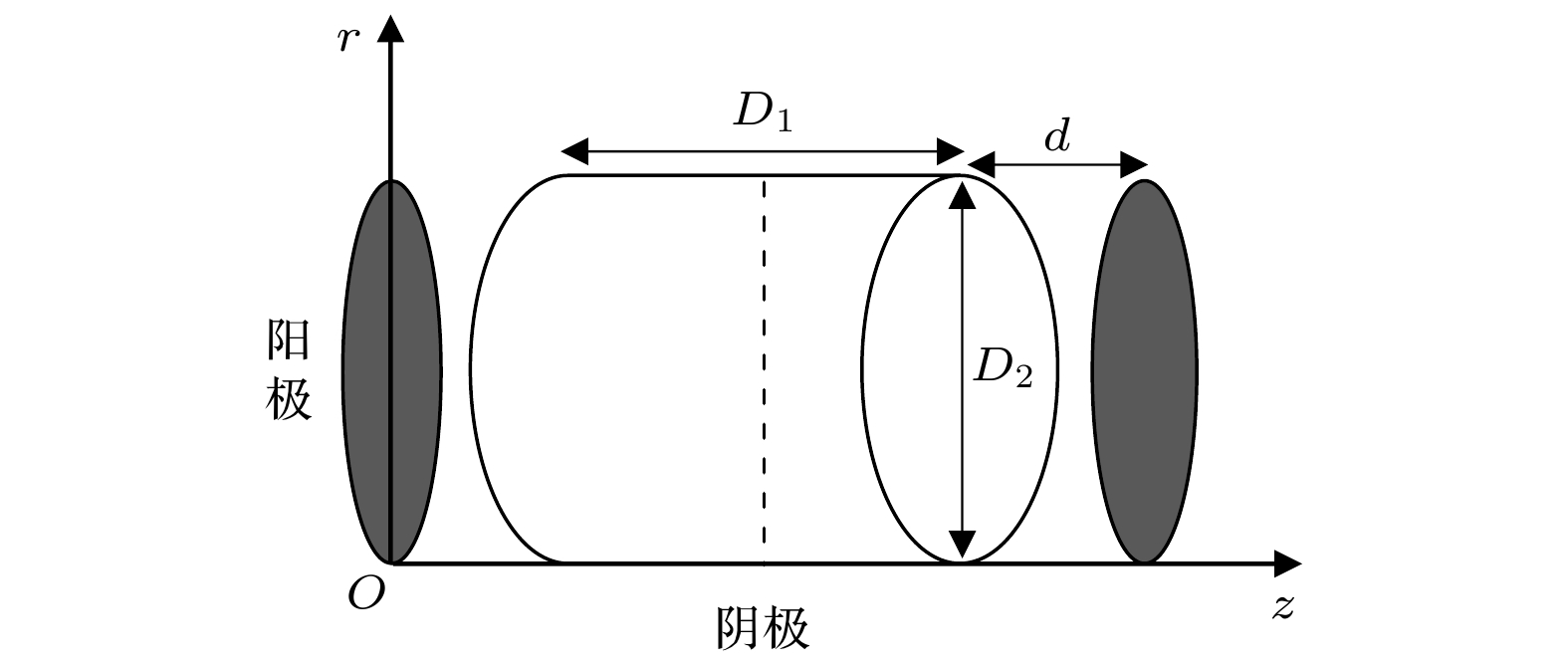
 下载:
下载:
